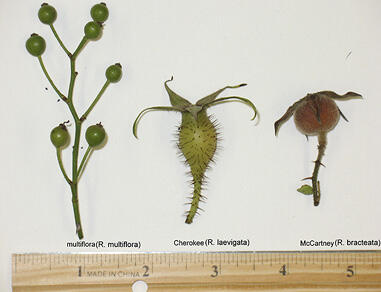P3280
Multiflora Rose
Problem
Multiflora rose or Japanese rose (Rosa multiflora Thunb. ex Murr.) [Syn. Rosa cathayensis (Rehd. & Wilson) Bailey] is a shrub native to Japan and Korea. It was introduced into the U.S. in 1868. It has been used for “living fences” and wildlife habitats.
It can be problematic in all Midsouth states, especially in pastures. Once established, multiflora rose is difficult to control. In pastures, it can significantly reduce the area available for grazing as livestock avoid the sharp prickles.
The four common escaped roses are Cherokee rose (Rosa laevigata Michx.), McCartney rose (Rosa bracteata Wendland), memorial rose (Rosa wichuraiana Crepin), and multiflora rose.
Regulations
Multiflora rose is noxious in Alabama, Iowa, Kentucky, Missouri, Pennsylvania, and West Virginia, and it is banned or prohibited in other states.
Description
Vegetative Growth
Multiflora rose is an erect, arching, deciduous shrub that can reach 15 feet high by 15 feet wide, but it is usually much smaller. Stems and leaves have short, recurved prickles. Leaves are alternate and odd-pinnate with seven to nine leaflets (Figure 1). Leaflets tend to be hairless above and hairy beneath. Each leaflet is obovate to elliptic, 0.5 to 2 inches long by 0.5 to just over 1 inch wide. Leaf margins are generally serrate.

Other roses are often confused with multiflora. Memorial rose foliage most closely resembles multiflora rose, but Cherokee and McCartney rose foliage is quite different (Figure 2).

Flowering
Flowers are clustered (Figure 1) with bracts (leaflike structures) that fall off at flowering. Flowering occurs May to June and then sparingly from September to October. Flowers have five smooth to hairy, lance-shaped, white petals that are 1.5 to 2.5 inches long. The hip (fruit) is green, then red at maturity, ellipsoid to ovoid in shape, and ¼-inch long.
Hips of multiflora rose occur in clusters, compared to solitary hips of Cherokee and McCartney roses (Figure 3). Inside the hips are typically seven achenes (true fruit that contain a seed), which are about 0.1 inches long and densely pubescent.

Dispersal
Individual plants may produce up to 500,000 seeds (or achenes) per year. Most seedlings emerge near the parent plant. However, many species of birds and mammals feed on the hips, widely dispersing the seeds. Despite this dispersal mechanism, wildlife food value is low to minor.
Stems that come into contact with soil can root. The impact of its use as a rootstock for cultivated roses upon its spread in the U.S. is not clear. Its use for ornament, wildlife, and hedges has most likely been the primary path of invasion in much of the U.S.
Multiflora rose is spread primarily by humans, birds, and mammals.
Habitat
Multiflora rose is a problem in pastures, fence rows, prairies, forest and roadside margins, and open woodlands. It can form dense thickets, replacing native vegetation. These thickets may provide habitat for certain wildlife.
Distribution
United States
Multiflora rose is widespread in the U.S., but it is apparently not escaped in some western plains and Rocky Mountain states. It occurs in states along the West Coast and from Minnesota to New Mexico east. It also occurs in most eastern states.
Midsouth
Multiflora rose has escaped in all Midsouth states.
Control Methods
Biological
There are no effective biological control methods for multiflora rose. While there may be occasional browsing, thorns deter animal grazing.
Cultural
There are no effective cultural control methods for multiflora rose.
Mechanical
Roses are generally shallow-rooted and can be easily uprooted by bulldozing. Uprooted plants should be destroyed by burning.
Chemical
There are several chemical control options for multiflora rose (Table 1). While most are applied to foliage, some can be applied to the soil around plants. Refer to the product label to determine the rate that can be applied for rose control as well as application sites. Herbicide treatments should be applied when environmental conditions are favorable for plant growth and after leaves have fully expanded.
Nonionic surfactant at 1 quart per 100 gallons spray solution should be used with foliar treatments. Soil-applied treatments must have rainfall to activate the herbicide. Rose response to soil-applied herbicides is longer than that of foliar treatments because soil-applied herbicides must be absorbed through the roots. Aminocyclopyrachlor, hexazinone, imazapyr, and picloram herbicides are more active in soil compared to other products, and these may provide superior residual control of new plants from seed in the soil seedbank.
|
Herbicide |
Concentration |
Trade Name |
Method |
|---|---|---|---|
|
aminocyclopyrachlor |
2 lb ae/gal |
Method |
foliar |
|
aminocyclopyrachlor + metsulfuron |
52.1% |
Streamline |
foliar |
|
aminopyralid + metsulfuron |
71.6% |
Chaparral, Opensight |
foliar |
|
aminopyralid + picloram + fluroxypyr |
0.49 + 0.97 + 0.83 lb ae/gal |
MezaVue |
foliar |
|
dicamba |
4 lb ae/gal |
Banvel, Clarity, Diablo, Rifle, Vanquish, etc. |
foliar |
|
dicamba + 2,4-D |
1 + 2.87 lb ae/gal |
Brash, Latigo, Rangestar, Weedmaster, etc. |
foliar |
|
glyphosate |
3 lb ae/gal |
Roundup, Cornerstone, Accord, etc. |
foliar |
|
hexazinone |
2 lb/gal |
Hexazinone, Velossa, Velpar, etc. |
foliar or soil |
|
imazapyr |
2 lb ae/gal |
Arsenal, Chopper, Ecomazapyr, Polaris, etc. |
foliar or soil |
|
metsulfuron |
60DF |
Ally, Escort, Cimarron, MSM, Patriot, Rometstol, etc. |
foliar |
|
metsulfuron + nicosulfuron |
71.2% |
Pastora |
foliar |
|
picloram |
2 lb ae/gal |
Tordon 22K, Triumph 22K |
foliar or soil |
|
picloram + 2,4-D |
0.54 + 2 lb ae/gal |
Grazon P+D, Gunslinger, Hirehand, Trooper, Tordon 101, etc. |
foliar |
|
picloram + fluroxypry |
0.67 + 0.67 lb ae/gal |
Surmount, Triumph |
foliar |
|
tebuthiuron |
20%P or 80%DF |
Spike |
foliar or soil |
|
triclopyr |
4 lb ae/gal |
Garlon, Remedy, Trycera, etc. |
foliar |
|
triclopyr + 2,4-D |
1 lb + 2 lb ae/gal |
Crossbow |
foliar |
|
triclopyr + fluroxypyr |
1.5 + 1 lb ae/gal |
Pasturegard, Cleargraze |
foliar |
References
Dirr, M. A. (1998). Manual of woody landscape plants: Their identification, ornamental characteristics, culture, propagation, and uses (5th ed.). Stipes Publishing LLC.
Miller, J. H. (2003). Nonnative invasive plants of southern forests: A field guide for identification and control. Southern Research Station.
USDA, NRCS. (2007). The PLANTS Database. National Plant Data Center.
The information given here is for educational purposes only. References to commercial products, trade names, or suppliers are made with the understanding that no endorsement is implied and that no discrimination against other products or suppliers is intended.
Publication 3280 (POD-03-25)
By John D. Byrd Jr., PhD, Extension/Research Professor, and Victor Maddox, PhD, Senior Research Associate, Plant and Soil Sciences.
The Mississippi State University Extension Service is working to ensure all web content is accessible to all users. If you need assistance accessing any of our content, please email the webteam or call 662-325-2262.
